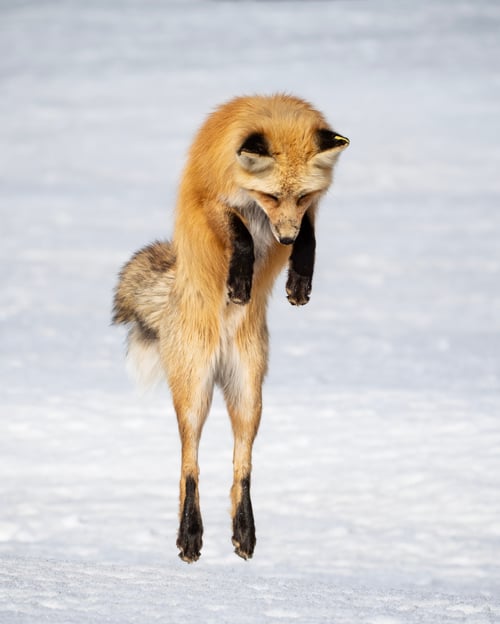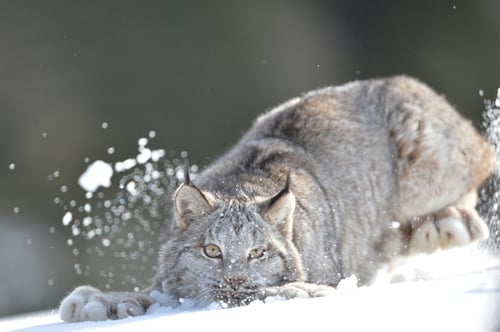While some of us are still savoring Thanksgiving leftovers, others are contemplating what to cook for the upcoming December holidays. Many cultures and religions observe special wintertime traditions, which often have roots in the winter solstice, the shortest day – December 21 this year. One thing most of these traditions have in common is special food. What’s your favorite winter-tradition food?
Contemplating the last slice of pecan pie, I wonder how those of my wildlife neighbors who stick around for winter are faring. What’s for dinner out there in the wild as the snow starts to fall? It takes a lot of energy to move around, stay warm, and survive when the temperatures drop – and that energy must come from food.

Fox Jumping in the Snow
Ungulates, like elk, deer, moose, and bighorn sheep, descend in elevation to their winter ranges, usually the lowest elevations in their home ranges. These winter habitats have shallower snow depths that enable travel between open foraging areas and sheltered forests or rock bands.
Our local bighorn sheep herd descends from the upper reaches of the Eagles Nest Wilderness to a south-facing slope above I-70 in east Vail. There, grass is exposed most of the winter, providing a dependable food source for our state mammal.
Deer favor nutritious shrubs that are easy to digest and high in energy. Elk are more generalists, being adapted to eating nutritionally deficient grasses as well as nutritious shrubs. And being taller, elk can browse on higher shrubs and trees, including even conifers when snow covers other plants.
Moose, with their even-longer legs, are hungrily consuming aspen and birch twigs and willow bushes.
Beavers, in their ice-bound dens, munch on tree limbs collected in summer and fall.
The beautiful and elusive lynx, with its huge back paws and long back legs, can fly across the surface of the snow to pounce on its favorite meal of snowshoe hare.

Lynx Playing in Snow
Some animals live off fat stored over summer and fall. Black bears enter a state called torpor, where their caloric needs are greatly diminished. Some rodents, like marmots, enter true hibernation.
Meanwhile, what’s for dinner under the snow? There’s a whole host of tiny creatures living in the subnivean zone, the area between the ground and the bottom of the snowpack where temperatures don’t drop below 32oF. Mice, voles, insects, and spiders use a network of tunnels to move about and forage for food on the ground. While some critters scavenge, others live off what they’ve collected. The amazing pika works tirelessly all summer gathering grasses, thistles, and wildflowers to munch on under a blanket of insulating snow.
Some carnivores, like red foxes and weasels, will listen for scurrying sounds under the snow, then suddenly leap into the air and pounce into the subnivean zone to grab their unsuspecting prey.
Many local birds overwinter in Eagle County. Some, like Clark’s nutcracker, stash food to survive winter. Others, like bald eagles, fish and scavenge throughout the winter months. Carrion anyone?
And, during Indigenous Peoples Month, let’s remember the local indigenous peoples who lived sustainably off these lands for millennia. During summers, the Utes, or Nuchu, hunted wildlife and gathered roots, berries, nuts, and seeds. They processed and stored these foods, and then carried them on their nomadic journeys to lower, warmer climes for the winter.
So, this winter, while sharing your favorite traditions around the table with family and friends, remember your wildlife neighbors, and the people who came before us, and give a nod of respect to their winter survival skills.
Frances Hartogh is a volunteer wilderness ranger for ESWA, the Eagle Summit Wilderness Alliance. ESWA is an all-volunteer nonprofit that helps the U.S. Forest Service preserve and protect the four Wilderness Areas in Eagle and Summit counties.







